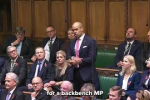
On 19th January, Anas Mezenner was walking home when he was involved in an altercation that led to him being stabbed. He died in hospital seven hours later. Five boys were charged with his murder, all of whom were aged between 14 and 18. This is not an isolated incident within Tottenham. On 17th February, a taxi driver was found fatally stabbed in his car. Six boys were charged with his murder, all of whom were under 18 at the time of the incident, three of whom were 15 years old. On 8th March, Nikolay Pandev was stabbed to death. Two boys aged 15 and 17 were charged with his murder.
There have been four murders in Tottenham this year. Of the 14 subsequently charged, 13 were children when the murders occurred. It is ironic that the local MP, David Lammy, has been silent regarding the issue of serious youth violence within his constituency despite the fact that he is the Shadow Justice Secretary.
The figures around serious youth violence should alarm anyone and particularly those who are parents to teenage boys who are as often the victim as they are the perpetrator. Within Haringey, three-quarters of victims are aged between 15 and 19. As of last year, Haringey was the second worst London Borough for knife crime offences. On 17th March, an Opinium poll on the Mayoral election asked participants what Police should have as their main priority over the next 12 months. 56 per cent of respondents listed knife crime as the main priority.
With the forthcoming London Mayoral Election, Londoners have the opportunity to make their vote heard. Sadiq Khan has shown that he will be quick to blame any correlation between his tenure and the rise in serious youth violence upon austerity. As he showed in the BBC debate, he is keener to highlight Shaun Bailey’s role as Youth and Police Adviser nearly a decade ago, than shoulder responsibility for any of the decisions taken whilst he has been at the helm. The manifesto for his mayoral campaign is 102 pages long and yet contains only two references to knife crime; there are twice as many references to racism.
Rival candidates have done little more to address the issue. The Liberal Democrats’ replacement candidate, Luisa Porritt, and the Green Party’s repeat candidate, Sian Berry, have both avoided any serious discussion of crime, the latter obliquely referring to it as “Safety”; Porritt focussing on the rebranding of the police as a “Service” rather than a “Force”. It is not the nomenclature of the Met that young men in London are wary of.
Despite his blend of truculence and grandstanding, Sadiq Khan is still a shrewd and astute politician. He knows he cannot afford to expose his heel, Achilles-like, whilst cloaked in the armour of identity politics, and so exploits the benefits of incumbency, pointing to the establishment of the Violence Reduction Unit and the recruitment of 1,300 additional officers as successes without the need to articulate whether they have been effective. The fact remains that knife crime has risen steadily under Khan’s tenure, with offences in the prior three years up to 2020 higher than under any previous Mayor.
The topic of serious youth violence and how best to tackle it is Shaun Bailey’s area of expertise. If you have ever heard him speak about the topic it is clear that he is a man who cares deeply about the issue, the improvement of outcomes for those vulnerable to it, and the impact upon families blighted by it.
Whilst this is a topic that all candidates intend to address at some level, what more could be done beyond the measures intended to resonate across all demographics?
Investment in youth services alone is unlikely to be enough. Research has shown that the majority of knife related offences involving young people occur between 3pm-6pm in the few hours after school. Re-establishing youth services will be key to reducing the likelihood of vulnerable children finding themselves in the wrong place at the wrong time. However, for young people, predominantly boys, mired in a milieu of such toxicity that they feel compelled to carry an offensive weapon in the belief that it makes them safe, access to table-tennis and DJ equipment is unlikely to provide reassurances that any potential threat has dissipated. There is a deeper-seated issue as to why such altercations continue to occur; not every child involved is a member of a gang or involved in county lines trafficking. There is a critical need for robust public discussion around how to detoxify the environment which makes carrying a knife permissible.
Cultural issues must be addressed. If the media, national newspapers amongst them, continues to cynically valorise the most detrimental aspects of black culture and celebrate criminality via musicians who are directly and indirectly involved in some of the local rivalries and fatal violence that occurs, we will continue to give impressionable youngsters the greenlight that this is acceptable behaviour. The high-profile afforded by the media to the discussion of race could be far better employed discussing serious youth violence. But nobody is making their name publishing books about knife crime.
Additionally, the viral nature of social media illustrates the ease with which children otherwise on the fringe can become immersed and embroiled within a world where simply sharing your location can make you a target in an escalating contretemps. Social media companies must be held to account and forced to take firmer action on content that could be easily overlooked by those not familiar with the argot. Perceived slights can quickly become the catalyst for fatal confrontation.
The surrounding narrative of the issue must be more closely controlled. Opposition politicians gaslight communities by suggesting that young black men are victims of institutional racism due to disproportionate representation in the youth criminal justice system, but ignore the over-representation of young black men amongst the statistics of both victims and perpetrators of violent crime. As such, we are unlikely to stop families from suffering the heartbreak of losing their sons, either to prison or worse. The recent launch of the Hard Calls Saves Lives campaign, focused on the heart-breaking phonecalls that mothers have made following the violent deaths of their sons, is an example of how the voices of those impacted by such tragic events can resonate far more than those of any politician. The influence of strong characters, be they family members, teachers or local leaders, should not be underestimated. If David Lammy is as influential in Tottenham as his election results suggest, perhaps he should use his platform as Shadow Justice Secretary to prioritise addressing the issue blighting his own constituency and beyond.
Whatever the outcome of May’s election, London’s next Mayor will need a robust plan to combat an issue which continues to needlessly claim too many young lives across the capital. Any solution proposed will need to be far bolder, far more holistic, and far better resourced, than the ineffective piecemeal strategy currently in place.




